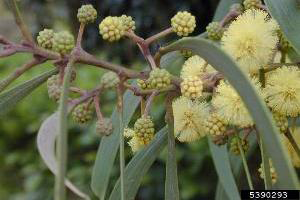Koa, with its frequently curly grain and attractive coloration, is considered the most valuable of the common native timber species in Hawaii.
Photo Credit: © Forest and Kim Starr, U.S. Geological Survey, Bugwood.org.
Acacia koa
Common Name: koa
Plant Functional Group: Evergreen broadleaf
Class > Order > Family: Magnoliopsida > Fabales > Fabaceae
